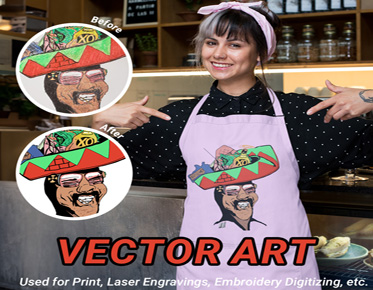The Lowdown on High-Density Screen Printing & Its Uses
High-density screen printing, a technique that defies the ordinary, stands out in the world of print for its ability to create textured, tactile designs that leap off the surface. Unlike traditional methods that lay ink flat, high-density printing builds layers of ink to achieve a raised, three-dimensional effect. This technique is not merely about adding a visual dimension; it’s about transforming the tactile experience of printed materials. High-density printing offers an innovative way to make designs more engaging and memorable. For the top-notch online vector conversion, don't hesitate to get in touch with us.
Why High-Density Printing Matters: The Impact on Design and Texture
High-density printing revolutionizes how designs interact with the viewer. The raised texture not only enhances the visual impact but also adds a physical sensation that invites touch. This technique is especially valuable in a crowded market where differentiation is key. By incorporating high-density printing, designers can create standout products that offer a unique sensory experience, making them not only eye-catching but also more memorable.
The Basics of High-Density Screen Printing
Defining High-Density Printing: Key Features and Characteristics
At its core, high-density screen printing is all about building layers of ink to achieve a three-dimensional effect. This process involves using specialty inks with a higher viscosity and applying multiple layers to create depth. The result is a print that feels raised and textured, offering a tactile quality that standard printing techniques cannot match. Key features include the ability to create bold, striking designs with a sense of depth and dimension, making high-density printing a favorite for applications that demand a strong visual and physical impact.
How High-Density Printing Works: The Process Explained
The process of high-density screen printing begins with the preparation of screens and inks. Specially formulated high-density inks, which are thicker and more viscous than traditional inks, are used to build up layers on the substrate. The design is applied in multiple passes, with each layer adding to the texture. After printing, the layers are cured to set the ink and ensure durability. This multi-layered approach allows for intricate designs and pronounced textures that stand out visually and physically.
Comparing High-Density to Traditional Screen Printing: What’s the Difference?
Traditional screen printing typically results in a flat, smooth finish, while high-density screen printing focuses on adding dimension. The primary difference lies in the ink application; traditional methods use a single layer of ink, whereas high-density techniques build up multiple layers to achieve a raised effect. This difference in approach not only alters the appearance but also the feel of the print. High-density prints offer a tactile experience that traditional prints lack, making them more suited for designs that aim to make a bold statement.
Materials and Inks
Choosing the Right Inks: Specialty Inks for High-Density Printing
For high-density screen printing, selecting the right ink is crucial. Specialty inks designed for high-density applications have higher viscosity and are formulated to build up layers without losing clarity or detail. These inks often include additives to enhance their thickness and ability to maintain a raised texture. Choosing the right ink ensures that the final print achieves the desired depth and dimensionality, and maintains its quality throughout the printing process.
Understanding Ink Viscosity: How It Affects the Print Quality
Ink viscosity plays a pivotal role in high-density printing. High-viscosity inks are thicker and more gel-like, allowing them to form the raised textures characteristic of high-density prints. The viscosity of the ink affects how well it builds up on the substrate, influencing the overall texture and clarity of the print. Properly managing ink viscosity is essential for achieving consistent results and ensuring that the final print has the desired tactile and visual impact.
Selecting Suitable Substrates: Materials That Work Best with High-Density Inks
Choosing the right substrate is key to achieving optimal results with high-density screen printing. Materials that work well include fabrics with a sturdy weave, such as cotton and canvas, which can support the added layers of ink without distortion. For non-textile applications, substrates like paper and certain plastics can also be suitable. The substrate should be chosen based on its ability to hold the ink layers and maintain the integrity of the high-density print.
Preparing for High-Density Printing
Screen Preparation: Coating and Exposing Screens for High-Density Prints
Preparing screens for high-density printing requires meticulous attention to detail. Begin by coating the screen with a high-quality emulsion that can handle the thick layers of ink used in high-density printing. After coating, expose the screen to light with your design film in place to create a precise stencil. Proper screen preparation ensures that the intricate details of the design are accurately reproduced in the raised print.
Design Considerations: Creating Artwork for High-Density Effects
When designing for high-density screen printing, consider how the artwork will translate into a three-dimensional print. Designs should incorporate elements that benefit from texture, such as bold graphics or intricate patterns that can be enhanced by the raised effect. Keep in mind the limitations of high-density printing, such as the potential for ink to spread slightly, and adjust the design accordingly to achieve the best results.
Equipment Setup: Adjusting Your Screen Printing Press for High-Density Printing
Adjusting your screen printing press for high-density printing involves several key modifications. Ensure that the press can handle the thicker inks and multiple passes required for high-density prints. You may need to adjust the squeegee pressure and angle to accommodate the increased ink build-up. Proper setup ensures that the press operates smoothly and delivers consistent, high-quality prints.
Printing Techniques and Tips
Layering for Effect: Techniques for Achieving the Desired High-Density Texture
Layering is a fundamental technique in high-density screen printing. Apply the ink in multiple passes, allowing each layer to dry before adding the next. This builds up the texture gradually, achieving the desired depth and dimension. Use a consistent technique to ensure even layering and avoid inconsistencies in texture. Techniques such as varying the squeegee pressure can also help create different effects and enhance the overall design.
Drying and Curing High-Density Prints: Ensuring Proper Set and Finish
Drying and curing high-density prints requires careful attention to ensure that the raised textures are set properly. High-density inks typically require more time to dry compared to standard inks due to their thickness. Use a conveyor dryer or heat press to apply gentle, consistent heat, ensuring that the ink is fully cured and the texture remains intact. Proper curing is essential for maintaining the print’s dimensionality and durability over time.
Managing Ink Build-Up: Tips for Maintaining Consistency and Quality
Managing ink build-up is crucial for achieving consistent high-density prints. Regularly check the ink’s thickness and adjust as needed to maintain a uniform texture. Avoid overloading the screen with ink, as this can lead to uneven prints and excess build-up. Use techniques such as squeegee control and ink flow management to ensure that each pass of the print contributes to a consistent, high-quality result.
Common Challenges and Solutions
Handling Ink Drying Times: Best Practices for Efficient Printing
Ink drying times can be a challenge with high-density printing due to the thicker layers of ink. To manage drying times efficiently, work in a well-ventilated area to speed up the evaporation process. Utilize drying racks or heat-assisted drying techniques to ensure that each layer of ink dries evenly and thoroughly. Regularly monitor the drying progress to avoid issues with smudging or incomplete curing.
Dealing with Print Clarity: Ensuring Sharp and Defined High-Density Images
Print clarity is essential for high-density printing, and achieving it requires attention to detail. Ensure that screens are properly prepared and that inks are correctly mixed to avoid issues with clarity. Use precise layering techniques and check the print regularly for sharpness and detail. Address any issues promptly to maintain the quality of the high-density prints.
Troubleshooting Issues: Solutions for Common High-Density Printing Problems
Common issues in high-density printing include uneven texture, bleeding, and inconsistent layering. To troubleshoot these problems, check the ink viscosity and adjust as needed. Ensure that screens are clean and properly coated, and monitor the print process for any signs of issues. Implementing preventive measures and addressing problems promptly helps maintain the quality and consistency of high-density prints.
Applications of High-Density Screen Printing
Textile Printing: How High-Density Inks Transform Apparel and Fabrics
In textile printing, high-density inks can dramatically transform apparel and fabrics. The raised textures create a unique look and feel, enhancing the visual impact of garments. High-density printing is ideal for designs that benefit from a tactile quality, such as logos, graphics, and patterns. This technique adds depth and interest to clothing, making it a popular choice for fashion and promotional items.
Promotional Products: Using High-Density Printing for Eye-Catching Swag
High-density printing is also effective for creating promotional products that stand out. Items such as tote bags, caps, and keychains benefit from the added texture and dimension that high-density inks provide. The tactile quality of high-density prints makes these products more engaging and memorable, ensuring that they leave a lasting impression on recipients.
Specialty Items: Applications in Non-Traditional Materials and Products
Beyond textiles and promotional items, high-density printing can be applied to a variety of specialty items. Materials like wood, metal, and acrylic can be enhanced with raised designs, making them ideal for custom gifts, awards, and decorative pieces. The versatility of high-density printing extends to a range of substrates, allowing for creative and unique applications.
Maintenance and Care
Maintaining Equipment: Keeping Your Press in Top Condition for High-Density Printing
Regular maintenance is crucial for keeping your screen printing press in optimal condition for high-density printing. Clean and inspect equipment regularly to ensure it operates smoothly and effectively. Address any issues promptly to avoid disruptions in the printing process and maintain the quality of high-density prints. Proper care extends the lifespan of your equipment and ensures consistent performance.
Cleaning and Storing Screens: Best Practices for Longevity and Performance
Cleaning and storing screens properly is essential for maintaining their performance and longevity. After each use, thoroughly clean screens to remove any residual ink and prevent clogging. Store screens in a dry, clean environment to protect them from damage and contamination. Implementing best practices for cleaning and storage helps preserve the quality of screens and supports consistent high-density printing results.
High-density screen printing offers a distinctive approach to printing with its ability to create raised, textured designs. This technique provides numerous benefits, including enhanced visual appeal, unique tactile experiences, and versatility across various applications. From apparel to specialty items, high-density printing adds depth and impact to designs, making it a valuable tool for standout print projects. By incorporating high-density printing, you can create memorable and engaging products that stand out in a competitive market. If this post piqued your curiosity and you wish to learn more about vector logo conversion, feel free to reach out to us.



